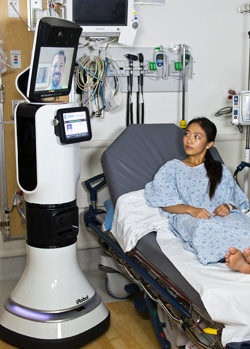Top 5 Commercial Applications for Robotic Companies

Posted on Mar 26, 2014 in Robotics
4 min read time
A lot of R & D, hard work and effort has been made by several companies over the last few years to push them to be on the leading edge in the robotic world. Sometimes, it is just a question of timing—having the right idea at the right moment for a specific field. Commercializing a robot is all about finding an application that will provide a good return on investment. Here are the commercial robotic applications that caught our attention.
1. Robotic Barista
Getting a good cuppa java between two classes or before a big study session is not always easy (you guys know about that!) Briggo has found the perfect combination between well brewed coffee and automation. The company actually developed a machine that replicates what the champion barista, Patrick Pierce, does every time. Inside those walls, a robotic mechanism grinds the coffee and uses a tamper, as well as the right water temperature to make your shot of espresso. This robot duplicates his movements so precisely that it even uses the exact same angle for the steaming wand as the one used by Pierce. The robotic barista is currently in operation at the University of Texas in Austin. The company raised $3.2 million last year and wants to expand their market by implanting machines in hospitals, airports and other schools.
"This is the most complex coffee machine on the planet." - Charles Studor, Briggo founder.

2. Exoskeleton
When talking about bionic suits or exoskeletons, people often think about futuristic military weapons. Ekso Bionics is actually changing this perception by developing, over the last five years, a suit that helps paraplegics walk again. The company has sold about 500 suits and has documented more than one million steps. The exoskeleton now costs $110,000 and the demand for the product is still increasing which should mean a price drop will take place anytime soon. Nathan Harding, Ekso Bionics’ CEO, claims to have a rock-solid argument to convince the insurance companies to cover their product. In fact, with the lifetime cost of a spinal-cord injury being around $4.6 million, just doing the math the choice is quite simple. The system has a low power consumption (5 watts) and has built-in knee and hip sensors that can detect weight transfer and can move accordingly when it’s time to go forward. Furthermore, the suit can be sized to a patient in five minutes and can guarantee a minimum of 200 steps during the first use.
"I think you're going to commonly see grandmothers in their hip new set of bionic legs." -Nathan Harding, Esko Bionics CEO
3. Human-Robot Collaboration
Although this subject has already been previously discussed on this blog, the manufacturing world continues to evolve. Boston-based Rethink Robotics has developed an affordable, working alongside-human robot that is helping manufacturing companies all around the world to solve their outsourcing problems. This human-shaped robot costs an affordable $22,000 and can fit in an assembly line very quickly. This robot is now implanted in several industries and Rethink Robotics is continually working on improving their product. Take a look at our COLLABORATIVE ROBOTS EBOOK to find out more about Baxter.
4. Robotic Doctor
Healthcare is often a question of time—things have to be done quickly and efficiently. To enhance the care that must be given to a patient, InTouch Health is producing a remote-presence robot. This robot is actually a telemedicine humanoid that can travel around the hospital and report the latest update on patients. The clinicians use a Wi-Fi connected iPad to control the robot. According to CEO, Yulun Wang, it’s particularly useful in emergency rooms where access to specialists via video can be the difference between the life and death of a patient. For example, a specialist can direct the robot to the bed of a patient while being on the other side of the hospital or even at home.
"We can optimize patient care by leveraging our scarce resources--physicians--so they can provide care across a larger area." -Yulun Wang, InTouch Health CEO.

5. Bio-Robotic
Since more and more people are becoming concerned about the quantities of chemicals in what they eat, Blue River Technology has come up with a solution to one of the main problems in agriculture: eliminate weeds without adding unnecessary amounts herbicides to food crops, genetically modifying the seeds or resorting to manual removal. The automated system is pulled behind a tractor and scans the soil to determine if the plant is a crop or a weed. By using advanced computer vision, soil images are processed in milliseconds and the spray can be oriented directly onto the weed's roots. The company is looking forward to decreasing the negative impact on the environment by not using pesticides, while continuing to maintain and enhance the product quality. By using this process, farmers can eventually increase the margin on their product, which could in turn lead to more affordable food for consumers.
Having technology around us that not only enhances productivity in manufacturing processes, but also makes our life easier is always good to see. As I said, having the right idea at the right moment can be life changing. Finding applications that give your company the leading edge is crucial, therefore you should definitely keep thinking outside of the box. The best example of this is the software (Kinetiq Teaching) that we have developed for automatic welding. We were focusing on our different grippers and when we had the opportunity to diversify our field of applications. Keep your eyes open and jump on the next business opportunity to come your way!








Leave a comment